南京夫子庙英文导游词
夫子庙英语导游词
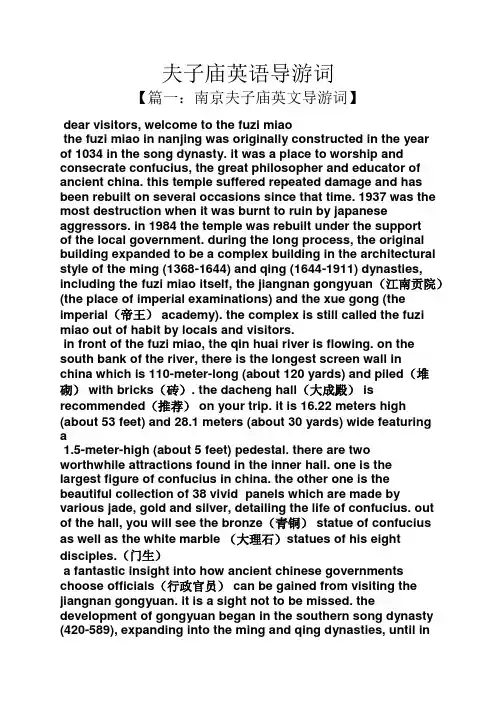
夫子庙英语导游词【篇一:南京夫子庙英文导游词】dear visitors, welcome to the fuzi miaothe fuzi miao in nanjing was originally constructed in the yearof 1034 in the song dynasty. it was a place to worship and consecrate confucius, the great philosopher and educator of ancient china. this temple suffered repeated damage and has been rebuilt on several occasions since that time. 1937 was the most destruction when it was burnt to ruin by japanese aggressors. in 1984 the temple was rebuilt under the supportof the local government. during the long process, the original building expanded to be a complex building in the architectural style of the ming (1368-1644) and qing (1644-1911) dynasties, including the fuzi miao itself, the jiangnan gongyuan(江南贡院)(the place of imperial examinations) and the xue gong (the imperial(帝王) academy). the complex is still called the fuzi miao out of habit by locals and visitors.in front of the fuzi miao, the qin huai river is flowing. on the south bank of the river, there is the longest screen wall inchina which is 110-meter-long (about 120 yards) and piled(堆砌) with bricks(砖). the dacheng hall(大成殿) is recommended(推荐) on your trip. it is 16.22 meters high (about 53 feet) and 28.1 meters (about 30 yards) wide featuringa1.5-meter-high (about 5 feet) pedestal. there are twoworthwhile attractions found in the inner hall. one is thelargest figure of confucius in china. the other one is the beautiful collection of 38 vivid panels which are made by various jade, gold and silver, detailing the life of confucius. out of the hall, you will see the bronze(青铜) statue of confucius as well as the white marble (大理石)statues of his eight disciples.(门生)a fantastic insight into how ancient chinese governments choose officials(行政官员) can be gained from visiting the jiangnan gongyuan. it is a sight not to be missed. the development of gongyuan began in the southern song dynasty (420-589), expanding into the ming and qing dynasties, until inthe reign of emperor guangxu in the qing dynasty. it developed to be the biggest exanimation school in china. the main building of gongyuan is the three-storied mingyuan tower which is surrounded by 20,644 examination cells, called haoshe in chinese. now, a specialized museum on the imperial civil examination system is built here. visitors also have the opportunity to take simulated exams and experience the joys and sorrows of the candidates.the area around the temple consists of a series of tourist shops, snack bars, restaurants and tea cafes. they all appear to be in the architectural style of the ming and qing style. a variety of snacks encompassing eight of the most famous flavours are available for purchase at here. everyones individual tastes are well catered for. they are necessary parts of food culture in nanjing.【篇二:夫子庙导游词】南京夫子庙导游词英文考试版(2008-07-30 16:27:03)孔庙和秦淮河风光带1:the confucius temple, located [lou?keitid位于]at the qinhuai river scenic[si:nik风景的] area, 孔庙位于秦淮河风光带6the temple is the place for people to pay worship to confucius.庙是供人们崇拜孔子的地方 7:the confucius temple here in nanjing was first built in 1034孔庙在南京第一次建于1034。
介绍夫子庙英语作文
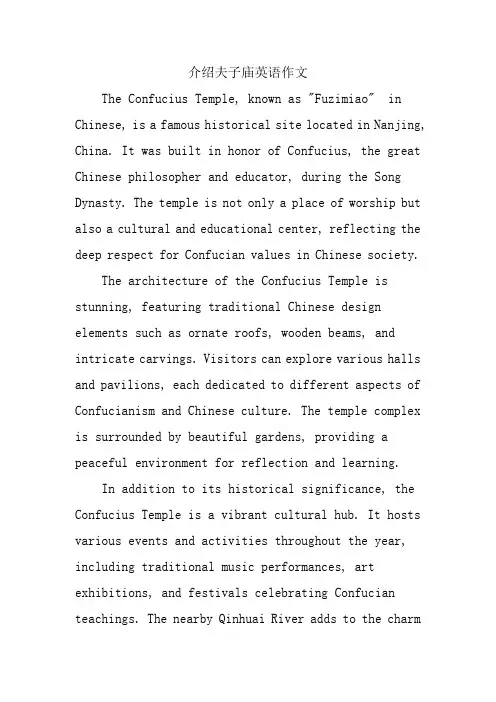
介绍夫子庙英语作文The Confucius Temple, known as "Fuzimiao" in Chinese, is a famous historical site located in Nanjing, China. It was built in honor of Confucius, the great Chinese philosopher and educator, during the Song Dynasty. The temple is not only a place of worship but also a cultural and educational center, reflecting the deep respect for Confucian values in Chinese society.The architecture of the Confucius Temple is stunning, featuring traditional Chinese design elements such as ornate roofs, wooden beams, and intricate carvings. Visitors can explore various halls and pavilions, each dedicated to different aspects of Confucianism and Chinese culture. The temple complex is surrounded by beautiful gardens, providing a peaceful environment for reflection and learning.In addition to its historical significance, the Confucius Temple is a vibrant cultural hub. It hosts various events and activities throughout the year, including traditional music performances, art exhibitions, and festivals celebrating Confucian teachings. The nearby Qinhuai River adds to the charmof the area, offering scenic boat rides that allow visitors to appreciate the beauty of the surroundings.Overall, the Confucius Temple is a must-visit destination for anyone interested in Chinese history and culture. It serves as a reminder of the lasting influence of Confucian philosophy on Chinese society and continues to inspire people today.中文翻译:夫子庙,中文称为“夫子庙”,是中国南京著名的历史遗址。
夫子庙的特色英文介绍
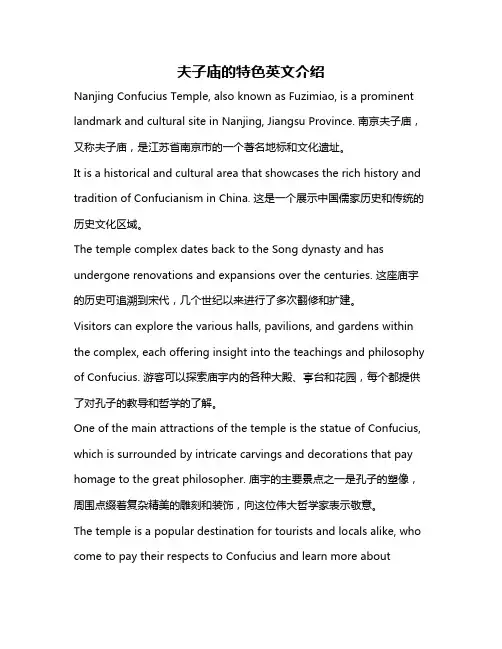
夫子庙的特色英文介绍Nanjing Confucius Temple, also known as Fuzimiao, is a prominent landmark and cultural site in Nanjing, Jiangsu Province. 南京夫子庙,又称夫子庙,是江苏省南京市的一个著名地标和文化遗址。
It is a historical and cultural area that showcases the rich history and tradition of Confucianism in China. 这是一个展示中国儒家历史和传统的历史文化区域。
The temple complex dates back to the Song dynasty and has undergone renovations and expansions over the centuries. 这座庙宇的历史可追溯到宋代,几个世纪以来进行了多次翻修和扩建。
Visitors can explore the various halls, pavilions, and gardens within the complex, each offering insight into the teachings and philosophy of Confucius. 游客可以探索庙宇内的各种大殿、亭台和花园,每个都提供了对孔子的教导和哲学的了解。
One of the main attractions of the temple is the statue of Confucius, which is surrounded by intricate carvings and decorations that pay homage to the great philosopher. 庙宇的主要景点之一是孔子的塑像,周围点缀着复杂精美的雕刻和装饰,向这位伟大哲学家表示敬意。
南京夫子庙英文介绍作文
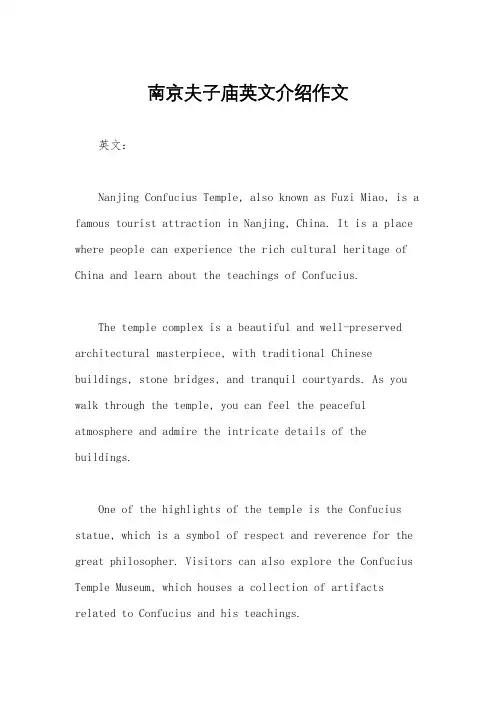
南京夫子庙英文介绍作文英文:Nanjing Confucius Temple, also known as Fuzi Miao, is a famous tourist attraction in Nanjing, China. It is a place where people can experience the rich cultural heritage of China and learn about the teachings of Confucius.The temple complex is a beautiful and well-preserved architectural masterpiece, with traditional Chinese buildings, stone bridges, and tranquil courtyards. As you walk through the temple, you can feel the peaceful atmosphere and admire the intricate details of the buildings.One of the highlights of the temple is the Confucius statue, which is a symbol of respect and reverence for the great philosopher. Visitors can also explore the Confucius Temple Museum, which houses a collection of artifacts related to Confucius and his teachings.In addition to the historical and cultural significance, Fuzi Miao is also a vibrant shopping and dining area. There are numerous shops selling traditional Chinese handicrafts, souvenirs, and delicious local snacks. It's a great placeto immerse yourself in the local culture and enjoy some authentic Chinese cuisine.Overall, a visit to Nanjing Confucius Temple is a must for anyone interested in Chinese history and culture. It'sa place where you can learn, relax, and experience the essence of traditional China.中文:南京夫子庙,又称夫子庙,是中国南京著名的旅游景点。
南京夫子庙英文导游词
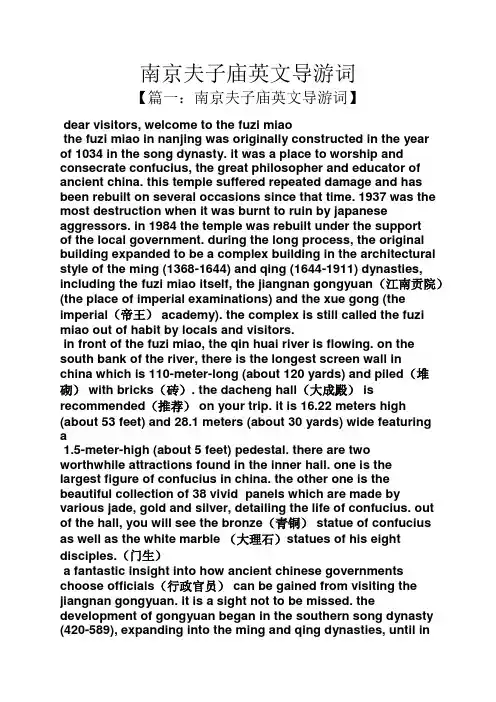
南京夫子庙英文导游词【篇一:南京夫子庙英文导游词】dear visitors, welcome to the fuzi miaothe fuzi miao in nanjing was originally constructed in the yearof 1034 in the song dynasty. it was a place to worship and consecrate confucius, the great philosopher and educator of ancient china. this temple suffered repeated damage and has been rebuilt on several occasions since that time. 1937 was the most destruction when it was burnt to ruin by japanese aggressors. in 1984 the temple was rebuilt under the supportof the local government. during the long process, the original building expanded to be a complex building in the architectural style of the ming (1368-1644) and qing (1644-1911) dynasties, including the fuzi miao itself, the jiangnan gongyuan(江南贡院)(the place of imperial examinations) and the xue gong (the imperial(帝王) academy). the complex is still called the fuzi miao out of habit by locals and visitors.in front of the fuzi miao, the qin huai river is flowing. on the south bank of the river, there is the longest screen wall inchina which is 110-meter-long (about 120 yards) and piled(堆砌) with bricks(砖). the dacheng hall(大成殿) is recommended(推荐) on your trip. it is 16.22 meters high (about 53 feet) and 28.1 meters (about 30 yards) wide featuringa1.5-meter-high (about 5 feet) pedestal. there are twoworthwhile attractions found in the inner hall. one is thelargest figure of confucius in china. the other one is the beautiful collection of 38 vivid panels which are made by various jade, gold and silver, detailing the life of confucius. out of the hall, you will see the bronze(青铜) statue of confucius as well as the white marble (大理石)statues of his eight disciples.(门生)a fantastic insight into how ancient chinese governments choose officials(行政官员) can be gained from visiting the jiangnan gongyuan. it is a sight not to be missed. the development of gongyuan began in the southern song dynasty (420-589), expanding into the ming and qing dynasties, until inthe reign of emperor guangxu in the qing dynasty. it developed to be the biggest exanimation school in china. the main building of gongyuan is the three-storied mingyuan tower which is surrounded by 20,644 examination cells, called haoshe in chinese. now, a specialized museum on the imperial civil examination system is built here. visitors also have the opportunity to take simulated exams and experience the joys and sorrows of the candidates.the area around the temple consists of a series of tourist shops, snack bars, restaurants and tea cafes. they all appearto be in the architectural style of the ming and qing style. a variety of snacks encompassing eight of the most famous flavours are available for purchase at here. everyones individual tastes are well catered for. they are necessary parts of food culture in nanjing.【篇二:夫子庙英文简介】confucius temple is one of the most famous places in nanjing. it was built to memorize confucius, and used to hold imperial examination. but now, it is a scenic spot. confucius temple is very beautiful. you can taste many famous nanjing’s food there, and you can also visit the lantern festival by boat on qinhuai river at night. it attracts many tourists all around the world every year. at the southwest of confucius temple, there is a narrow alley called wuyixiang. it is also very famous. if you come to nanjing, don’t forget to visit confucius temple! i’m looking forward to meeting you in nanjing. thank you.【篇三:13年最新南京夫子庙导游词】夫子庙 a【景点概况】1分30秒1、秦淮河简介2、夫子庙景区特色及历史沿革3、5a级景区等各位游客大家好,现在我们来到秦淮河畔夫子庙游览。
2018-南京夫子庙英语导游词-推荐word版 (3页)
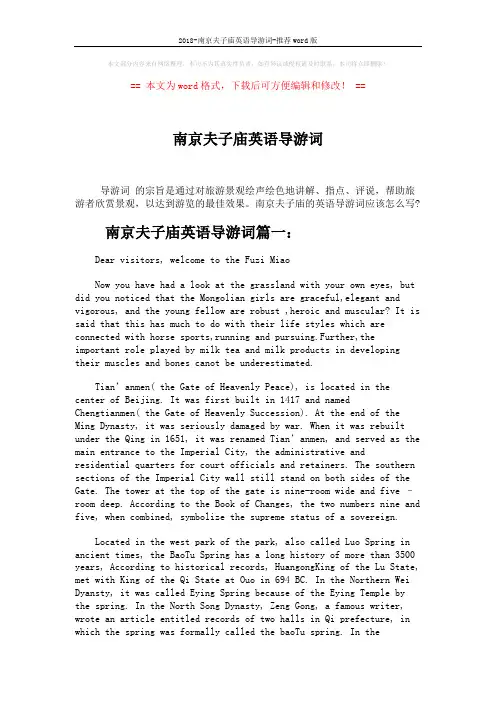
本文部分内容来自网络整理,本司不为其真实性负责,如有异议或侵权请及时联系,本司将立即删除!== 本文为word格式,下载后可方便编辑和修改! ==南京夫子庙英语导游词导游词的宗旨是通过对旅游景观绘声绘色地讲解、指点、评说,帮助旅游者欣赏景观,以达到游览的最佳效果。
南京夫子庙的英语导游词应该怎么写?南京夫子庙英语导游词篇一:Dear visitors, welcome to the Fuzi MiaoNow you have had a look at the grassland with your own eyes, but did you noticed that the Mongolian girls are graceful,elegant and vigorous, and the young fellow are robust ,heroic and muscular? It is said that this has much to do with their life styles which are connected with horse sports,running and pursuing.Further,theimportant role played by milk tea and milk products in developingtheir muscles and bones canot be underestimated.Tian’anmen( the Gate of Heavenly Peace), is located in thecenter of Beijing. It was first built in 1417 and namedChengtianmen( the Gate of Heavenly Succession). At the end of the Ming Dynasty, it was seriously damaged by war. When it was rebuilt under the Qing in 1651, it was renamed T ian’anmen, and served as the main entrance to the Imperial City, the administrative andresidential quarters for court officials and retainers. The southern sections of the Imperial City wall still stand on both sides of the Gate. The tower at the top of the gate is nine-room wide and five –room deep. According to the Book of Changes, the two numbers nine and five, when combined, symbolize the supreme status of a sovereign.Located in the west park of the park, also called Luo Spring in ancient times, the BaoTu Spring has a long history of more than 3500 years, According to historical records, HuangongKing of the Lu State, met with King of the Qi State at Ouo in 694 BC. In the Northern Wei Dyansty, it was called Eying Spring because of the Eying Temple bythe spring. In the North Song Dynasty, Zeng Gong, a famous writer, wrote an article entitled records of two halls in Qi prefecture, in which the spring was formally called the baoTu spring. In theJinDynasty, a stele was erected by the spring, saying that the BaoTu Spring was first among the 72 famous springs.The Fuzi Miao in Nanjing was originally constructed in the yearof 1034 in the Song Dynasty. It was a place to worship and consecrate Confucius, the great philosopher and educator of ancient China. This temple suffered repeated damage and has been rebuilt on several occasions since that time. 1937 was the most destruction when it was burnt to ruin by Japanese aggressors. In 1984 the temple was rebuilt under the support of the local government. During the long process, the original building expanded to be a complex building in the architectural style of the Ming (1368-1644) and Qing (1644-1911) dynasties, including the Fuzi Miao itself, the Jiangnan Gongyuan (the place of imperial examinations) and the Xue Gong (the Imperial Academy). The complex is still called the Fuzi Miao out of habit by locals and visitors.南京夫子庙英语导游词篇二:The Confucius temple in nanjing, often referred to as the Confucius temple, is a temple in gongyuan street, north of qinhuai river, nanjing. "Fu zi" was the title of Confucius disciples to Confucius. At present, the qinhuai scenic area, which is the centerof the temple and the city of the temple, is a cultural activity center integrating culture, tourism, shopping, service and other functions. There is a temple elementary school nearby.Confucius temple scenic spot of the ancient architectural complexes by Confucius temple, east, south Hiram's hospital and so on, the six dynasties to the Ming and qing dynasties, the tide polymersin Confucius temple area, known as the "six dynasties powders to" hub for jiangnan culture, is the core of the beside qinhuai scenery zone. Fuzi temple market is a famous traditional ancient market in China. The jinling Lantern Festival, which is held at the temple ofConfucius during the Spring Festival to the Lantern Festival, is oneof the most important activities during the Spring Festival.The fuzi temple was built in the first year of song dynasty (1034) and was expanded from the old site of the eastern jin dynasty. In the southern song dynasty, it was destroyed by fire and destroyed by fire, and the shaoxing period rebuilt, for jiankang fu xue, while building the imperial court of jiangnan; The yuan dynasty is the ji qing lu science, the early Ming dynasty is the imperial prison, and then the tianfu school; The qing dynasty became a county of jiangning andshangyuan county, which was severely damaged by the Japanese army's incineration in 1937 after the reconstruction of the qing dynasty (1869).In 1984, the people's government of the city and district protected the cultural heritage of the ancient capital. Through the scientific demonstration and planning of relevant experts, several funds were allocated, and years of careful maintenance and reconstruction were made. Today, the temple of Confucius has been renewed and magnificent. Known as qinhuai scenic spot, it has become the characteristic landscape area of the ancient city of nanjing, and is also a popular tourist attraction at home and abroad. In 1991, it was rated as one of the "40 best tourist attractions" in China.Confucius temple before paichi by qinhuai river, the north by the whole stone carved into a boulder fence was built MingZhengDe nine years (in 1514), the nanjing Confucius temple reserves the most well-preserved ancient buildings; The south bank stone wall was built in the three years (1575), 110 meters long and 10 meters high. In front of the north bank temple, there are star pavilions and sileting; The central axis has the lattice star gate, dacheng door, dacheng hall, mingde hall, zang jingge; The temple has a star pavilion.以下文字仅用于测试排版效果, 请使用时删除!冬是清寒的。
南京夫子庙英文介绍作文
南京夫子庙英文介绍作文Title:南京夫子庙: A Cultural Gem in the Heart of the Ancient City。
1. (Embracing the Enigma of History) Nestled in the bustling heart of南京市, a beacon of ancient wisdom, lies the majestic南京夫子庙. This ain't just a place; it's a living testament to the rich tapestry of Chinesecivilization.2. (A Beacon of Learning) Known as the Confucius Temple, it's not hard to imagine the scholarly aura that oncefilled its halls. Its grand architecture, a fusion of Ming and Qing styles, whispers stories of scholars and sages, their pens dipped in ink and wisdom.3. (A Hub of Trade and Culture) Don't be fooled by its scholarly facade; this place was also a bustling marketplace. The bustling bazaars, echoing with the soundsof haggling, symbolize the city's commercial vitality, atestament to its past as a trading hub.4. (A Cultural Feast) The annual Qinhuai Lantern Festival, a spectacle of light and color, brings the temple to life. The vibrant lanterns, each with a tale, paint a vivid picture of the city's festive spirit.5. (A Living Museum) Today, it's not just a place to visit; it's a place to connect. Tourists and locals alike, find solace in the tranquil gardens, where the whispers of the past blend seamlessly with the present.6. (A Call to Reflection) As you wander its cobbled streets,南京夫子庙 invites you to ponder the timeless lessons of Confucianism. It's a place where history and tradition meet the ever-evolving present, a living reminder of the city's enduring spirit.In essence,南京夫子庙 is a living, breathing entity, a fusion of past, present, and future, a place where every visit is a journey into the soul of南京. So, come, letthis cultural gem enchant you.。
夫子庙英语介绍
夫子庙英语介绍Nanjing Confucius Temple, also known as Fuzi Miao, is a renowned historical and cultural site located in the heart of Nanjing, China. 南京夫子庙,又称夫子庙,是位于中国南京市中心的知名历史文化景点。
Built during the Song dynasty, this ancient temple is dedicated to the memory of Confucius, the great philosopher and educator of ancient China. 建于宋朝时期,这座古老的庙宇致力于纪念孔子,中国古代伟大的哲学家和教育家。
The temple complex covers an area of around 2 hectares and is a significant symbol of Confucian culture in Nanjing. 该庙宇占地约2公顷,是南京儒家文化的重要象征。
Apart from its historical significance, the temple is also a popular tourist attraction, drawing people from all over the world due to its architectural beauty and serene atmosphere. 除了具有历史意义外,庙宇还是一个受欢迎的旅游胜地,由于其建筑美和宁静的氛围吸引着来自世界各地的游客。
One of the most striking features of Nanjing Confucius Temple is its intricate architectural design, which reflects traditional Chinese style and craftsmanship. 南京夫子庙最引人注目的特色之一是其复杂的建筑设计,反映了传统中国风格和工艺。
2022南京夫子庙英文导游词
南京夫子庙英文导游词范文
作为一位精彩的导游人员,编写导游词是必不行少的,一篇完整的导游词,其结构一般包括习惯用语、概括介绍、重点讲解三个部分。那么你有了解过导游词吗?以下是我为大家整理的南京夫子庙英文导游词范文,仅供参考,欢迎大家阅读。
Dear visitors, welcome to the Fuzi Miao
The area around the temple consists of a series of tourist shops, snack bars, restaurants and tea cafes. They all appear to be in the architectural style of the Ming and Qing style. A variety of snacks encompassing eight of the most famous flavours are available for purchase at here. Everyones individual tastes are well catered for. They are necessary parts of food culture in Nanjing.
A fantastic insight into how ancient Chinese governments choose officials can be gained from visiting the Jiangnan Gongyuan. It is a sight not to be missed. The development of Gongyuan began in the Southern Song Dynasty (420-589), expanding into the Ming and Qing Dynasties, until in the reign of Emperor Guangxu in the Qing Dynasty. It developed to be the biggest exanimation school in China. The main building of Gongyuan is the three-storied Mingyuan Tower which is surrounded by 20,644 examination cells, called haoshe in Chinese. Now, a specialized museum on the imperial civil examination system is built here. Visitors also have the opportunity to take simulated exams and experience the joys and sorrows of the candidates.
南京夫子庙英语导游词_0
南京夫子庙英语导游词篇一:南京夫子庙导游词原文地址:南京夫子庙导游词英文考试版作者:南京导游词confucius[k?n’fu∫j?s孔子]temple[templ寺庙]&theQinhuairiverscenic[si:nik风光]area*ε?ri?地带]孔庙和秦淮河风光带1:Theconfuciustemple,located[lou’keitid位于]attheQinhuaiRiverscenic[si:nik风景的]area,孔庙位于秦淮河风光带2:isawell-knowntourist[tu:rist旅游者]resort[ri’zэ:t常去度假的地方]oftheancientcapitalnanjing.她是古都南京闻名的旅游度假地。
3theriverbanksofQinhuaiareknownforconfuciusTemple秦淮河因孔庙而闻名。
4andjointly[d3эintli连带地]calledtheconfuciustemplearea.因此也叫夫子庙地区。
5theconfuciustempleisnodoubt[daut怀疑]themostfamous.孔庙无疑是最著名的6Thetempleistheplaceforpeopletopayworship[w?:∫ip崇拜]toconfucius. 庙是供人们崇拜孔子的地方7:Theconfuciustemplehereinnanjingwasfirstbuiltin1034孔庙在南京第一次建于1034。
8andrebuilt[ri:blt重建]in1986重建于1986年9Thetempleweoftenmentioned[men∫?n提出]shouldinclude[inklu:d包括]threearchitectural[a:kitekt∫?r?建筑]complexes[kэmpleks群,综合体]:我们常提的孔庙应该包括三个建筑群:10thetempleofconfuciuswiththehallofgreatachievements[?’t∫i:vm?nt大成]asthemain[mein主要的]body,孔庙及主体建筑大成殿11thepalace[p?lis宫殿]oflearningandtheimperial[impi?ri?l帝国]examination[igz?mi’nei∫?n考试]center.学宫和国家考试中心。
